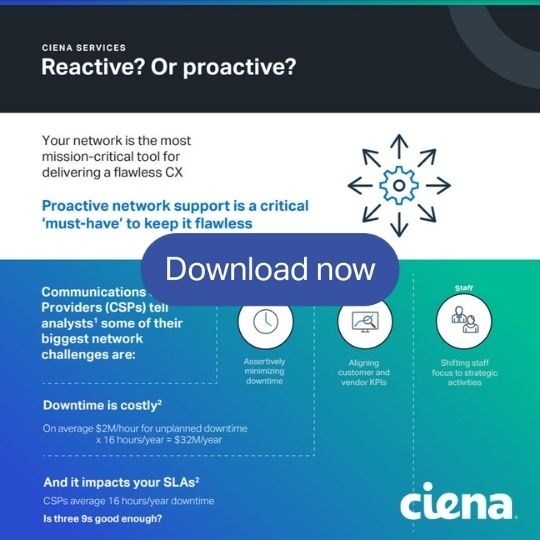IDC Survey: Advanced Support Services enables service providers to extend a seamless customer experience
 Rob Brothers is a Program Vice President for IDC's Datacenter and Support Services program. He focuses on worldwide support and deployment services for hardware and software and provides expert insight and intelligence on how enterprises should be addressing key areas for datacenter transformation and edge deployment and management strategies. Mr. Brothers draws on decades of industry experience to provide insights and actionable advice to assist vendors in developing, marketing, and delivering IT services.
Rob Brothers is a Program Vice President for IDC's Datacenter and Support Services program. He focuses on worldwide support and deployment services for hardware and software and provides expert insight and intelligence on how enterprises should be addressing key areas for datacenter transformation and edge deployment and management strategies. Mr. Brothers draws on decades of industry experience to provide insights and actionable advice to assist vendors in developing, marketing, and delivering IT services.
[Related reading: IDC's Curtis Price shares his insights from a recent Communication Service Provider Optimization Services survey that highlights the challenges CSPs are facing and how they see network optimization as a path forward.]
 The value of highly reliable networks continues to reach new heights as individuals increasingly rely on connectivity, and as businesses build out their operations on tightly interconnected networks that tie them with suppliers, partners, and customers. In many instances, the pandemic created greater expectations of what the network is capable of. In fact, we are at the forefront of an evolution that will usher in 5G, edge and IoT-based initiatives, as well as Industry 4.0 services that will support a wave of new solutions like autonomous vehicles and industrial use cases.
The value of highly reliable networks continues to reach new heights as individuals increasingly rely on connectivity, and as businesses build out their operations on tightly interconnected networks that tie them with suppliers, partners, and customers. In many instances, the pandemic created greater expectations of what the network is capable of. In fact, we are at the forefront of an evolution that will usher in 5G, edge and IoT-based initiatives, as well as Industry 4.0 services that will support a wave of new solutions like autonomous vehicles and industrial use cases.
In addition to new network usage patterns, communication service providers’ (CSPs) network strategy has shifted to focus on providing a superior customer experience. This is now key for CSP's as they seek to drive a “stickier” relationship with their customers and create a source of competitive differentiation in the market that is predicated on network availability and performance. Expectations for highly reliable, well-tuned networks will increase as the services that run on the network expand from basic connectivity to mission- and even life-critical services.
With a massive fixed and mobile infrastructure transformation underway, communication service providers have a forecasted global capex spend of over $300B in 2021, which is expected to grow dramatically as IoT and edge-based solutions develop and 5G infrastructure build increases. As a result, CSP's have an even greater need for solutions that keep network reliability and performance at high levels.
In a 2020 study, IDC estimated that CSPs worldwide have approximately 16 hours of downtime per year at a cost of $1.4M per hour. This number is an average; the impact of unplanned network downtime can be far greater, with a financial impact of $2.0M per hour on businesses that rely on the network, and the reputational damage to the CSP's brand. To ensure great customer experiences, and prevent downtime, CSPs are implementing proactive and predictive capabilities. In the same IDC study, the value of proactive and predictive capabilities became very evident when respondents stated that having these capabilities resulted in 14% fewer hours of downtime and 15% fewer downtime incidents per year.
 Having the right maintenance solutions in place can thus help CSPs dramatically reduce downtime, and – by association – provide higher network availability and performance that creates an excellent service experience for customers.
Having the right maintenance solutions in place can thus help CSPs dramatically reduce downtime, and – by association – provide higher network availability and performance that creates an excellent service experience for customers.
The ability to collect and analyze network telemetry data can enable faster strategic decisions regarding traffic, device, and software updates, as well as repair and maintenance operations. In IDC’s recently conducted CSP Support Services Survey, CSPs are looking for vendors to take on more of the risk and responsibility in the support and management of their networks, a shift that allows them to increase focus on strategic business initiatives. IDC’s research reveals 44% of CSPs plan to purchase advanced support contracts with more aggressive service levels to help satisfy greater SLAs and KPIs for their customers.
Of particular note, CSPs cited services like optimization and proactive support as those that they are willing to pay for through better support contracts. Optimized and proactive support services include items such as health notifications, guidance on how best to manage the infrastructure, and the ability to identify issues before they occur.
When choosing a vendor to partner with, technology and technology road maps are important; yet just as critical are the people, processes, and services that wrap around that technology.
Partner with a Strategic Vendor
In the same CSP Support Services Survey , respondents were asked about their top features and needs when evaluating support contracts. The below bullets highlight the top features and needs cited by operators:
- Proactive/preventive support services (notifications, ability to identify, diagnose and resolve issues before they impact the environment, parts replacement, health checks)
- Remote management of systems (patching and provisioning of systems)
- Optimization of the network environment on an ongoing basis
- Technical expertise and effective communication of support staff
The market has responded to what CSPs are seeking; the technology and capabilities offered by vendors have dramatically increased, allowing vendors to play a more integrated role in the communication service provider environments. In effect, CSPs are looking to support diverse traffic types with high performance requirements, as well as to invest in advanced support services to gain access to key capabilities that have greater value. With the appropriate support and maintenance solutions in place, communication service providers can deliver the kind of high network availability that creates an excellent service experience for customers.
As a result, advanced support capabilities are continually expanding and will be the predominant way vendors will assist CSPs in the future. The intelligence that vendors are building into their support offerings today provides better telemetry data to help keep networks highly available and keenly optimized, essentially making reactive support models relics of the past. With the dynamic nature of networks today, advanced features will become essential to operations.
When choosing a vendor to partner with, technology and technology road maps are important; yet just as critical are the people, processes, and services that wrap around that technology. The ever-changing network landscape demands a vendor that not only provides excellent technology but assesses how that technology will define the needs of the future. To deliver a highly satisfactory customer experience, a vendor should be looking out for the best interest of both the CSP as well as its customers.







